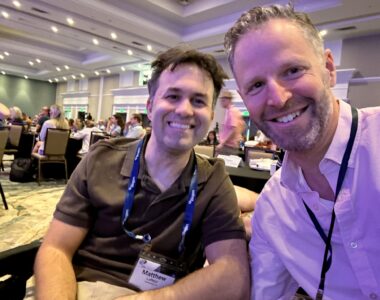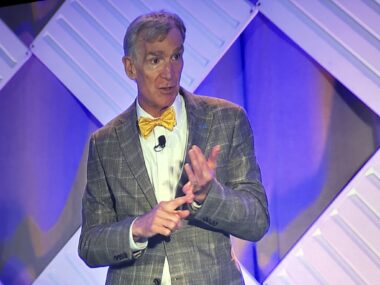From ‘Science Guy’ to ataxia advocate, I’m with Bill Nye
The celebrity scientist recently spoke at the NAF's annual conference

My dad, Freddie, and Ethan, my manager here at Bionews (the parent company of this website), sat on either side of me as we awaited the opening session of the National Ataxia Foundation‘s (NAF) annual conference on the last day of May. We eagerly anticipated seeing the first speaker on the conference schedule, the celebrity scientist Bill Nye, who is known as the “Science Guy.”
As the Florida sun relentlessly beat down outside, the large conference room was nearly full. Walt Disney World was so close to where we were that its influence was noticeable in the friendliness of the hotel staff.
The backdrop of the stage where Nye would speak was bedecked with multicolored designs resembling a strand of RNA. Two NAF staff members welcomed everyone to the largest annual gathering of ataxia patients in the country. My disorder, Friedreich’s ataxia, or FA, is the most common form of hereditary ataxia, but there are many other types, such as cerebellar, sensory, vestibular, acquired, and sporadic.

From left, Matt Lafleur and Ethan Ash await guest speaker Bill Nye at this year’s NAF conference in Orlando, Florida. (Photo by Ethan Ash)
My friend Andrew Rosen, who is CEO of NAF, introduced the man of the hour, whom everyone in the room was excited to hear from. Nye then took the stage in his trademark bow tie.
As the Science Guy talked at length about his family’s history with ataxia, which they referred to as their “glide” due to their odd gait, I could easily relate. Before I was diagnosed with FA, I believed that my own strange gait was just a personal quirk. It took a yearlong diagnostic odyssey for me to even learn the word “ataxia.” In Nye’s case, his family’s “glide” was identified as ataxia in late 2022.
Although Nye believed at the time that he also had ataxia, he acknowledges now that he is a sibling and child of family members who have it.
“Bill’s story is familiar to us in the ataxia world, in that this disease is often present in many generations of a family before being ultimately identified,” Rosen said. “Our work with Bill is so exciting because of his ability to take a complex scientific concept and make it easily accessible to his tens of millions of followers around the world.”
Despite the difficult subject matter, Nye delivered his talk with a witty charm that put the entire audience at ease and made us want to listen closely. That seemingly effortless charisma was something I was already familiar with.
Fourth time’s a charm
I first encountered Nye when I was a kid in the 1990s watching episodes of “Bill Nye the Science Guy” on TV. While my own nerdiness drew me more toward words and literature rather than chemistry and physics, I recognized a kindred, gleeful passion for enveloping yourself in what you love, no matter how offbeat others might find it.

Bill Nye at the podium for the Annual Ataxia Conference by the NAF. Courtesy of Ethan Ash.
Bill Nye discusses his family’s history of ataxia at the 2024 NAF conference in Orlando, Florida. (Photo by Ethan Ash)
The second time I chanced upon him was over a decade later, in a 2014 YouTube debate about evolution and creationism with Christian author Ken Ham. I was excited to see the Science Guy still following his passion and speaking about the merits of science to millions of online viewers.
Nye showed up on my screen again in a 2017 documentary titled “Bill Nye: Science Guy.” As I watched it, I couldn’t believe my longtime hero was being so vulnerable about his family’s recent discovery that they carried an inherited form of ataxia. I saw a different side of Nye in that documentary that projected the uncertainty of life with ataxia, something I also identified with. My respect for him only multiplied.
Now, seven years later, I was watching him speak live, directly in front of me. Now that his family’s ataxia has been identified as spinocerebellar ataxia type 27B, Nye has gotten deeply involved with NAF.
Welcome to the ataxia community, Bill. I can’t wait to see you use that cheerful passion of yours to spread awareness about ataxia. I hope to meet you one day to discuss two very important topics: science and hope.
Note: Friedreich’s Ataxia News is strictly a news and information website about the disease. It does not provide medical advice, diagnosis, or treatment. This content is not intended to be a substitute for professional medical advice, diagnosis, or treatment. Always seek the advice of your physician or another qualified health provider with any questions you may have regarding a medical condition. Never disregard professional medical advice or delay in seeking it because of something you have read on this website. The opinions expressed in this column are not those of Friedreich’s Ataxia News or its parent company, Bionews, and are intended to spark discussion about issues pertaining to Friedreich’s ataxia.








Mary Hogan
Thank you for your wonderful article. Raising awareness of ataxia helps us all. As a member of the Darby Glide club (aka SCA27B), it has been amazing to connect with others on their ataxia journey and collective work toward treatments and common goals. Way to go Bill - we appreciate you more than you know!
Matthew Lafleur
Thanks so much for reading and for the comment, Mary. I am as excited as you to watch the admirable Mr. Nye leave his mark on the ataxia community!
Dean
My hubby has ataxia. Atrophy brain neuropathy both feet. Been dealing 25yrs. I like to hear more about this terrible progression disease
Peggy Kryzsko
I have Hereditary Ataxia, the only 1 in family. It seems to me like I had episodes of not walking
esp3cially after having played basketball in high school an 8th grade.then I wouldn't have it again for number of yrs. Since my 70s my walking has been all over the place,my balance was off,couldn't walk a straight line.it took 2 yrs b4cmy primary Dr decided to do anything but I had to keep after her. I was then sent to 1 Neurologist an then another neurologist. I did physical therapy this past yr. My balance problems r still with me but am not all over the place.